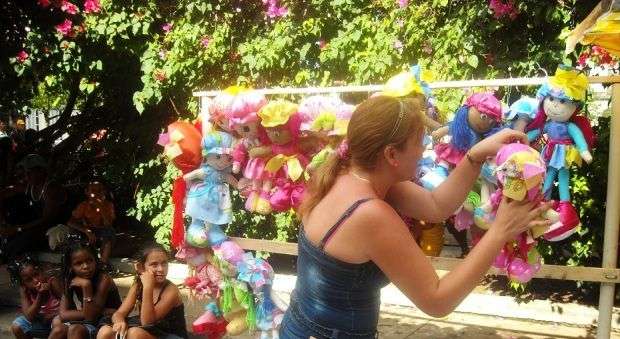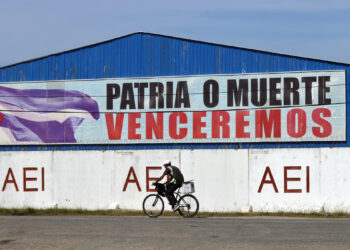Every year so many people in Cuba look forward to see the renewed floats of Las Charangas de Bejucal, Los guaracheros de Regla, the troupes, cheap beer, pork sandwiches … Everything that means the arrival of the carnival. In the city of Matanzas the event is cause for as much rejoicing.
“Do not mourn, that life is a carnival, / And it’s beautiful to live singing /” Celia Cruz sang the song Life is a carnival, by Puerto Rican singer Victor Manuelle, with music that invites you to participate in a cultural and gastronomic event which promises to forget pains.
However, there is a topic that has gained attention in recent editions of carnivals: the economic one. Therefore, to meet the demands of expenditure of this playful expression, identity of Cuban society as many others, is part of the agenda of the Cuban state interests.
These popular celebrations are done with a budgeted fund that governmental authorities in each municipality allocate for these purposes. Culture and economy go hand in hand at Matanzas´ carnivals and Cuba’s in general. They both form an inseparable symbiosis, since, besides being a celebration of culture, they have all the chances of also becoming a part of the economy of any city. Its people gathering potential has the capacity of achieving a multiplier effect of earnings and diversifying the services that can be hired for this activity.
Hence the carnival transcends the sense of popular participation to make room for consumption and becomes a source of temporary work contracts. It is not about raising prices to achieve higher profitability but to increase earnings with quality products and services; features that self-employed have proven capable of carrying out.
Heads and tails of expenditure
The 2013 Matanzas Carnival, dedicated to the 320th anniversary of the foundation of the city, is based on the basis of a preliminary draft budget. To the current day, the municipal government allocated a total of 1 349 000 Cuban pesos (CUP), from which they plan to spend 1 312 500 CUP, with which, among other activities, it is expected to hire artists from Matanzas Musical Center and also from Havana. This was stated by Fredy Castillo, finance municipal director of the so-called City of bridges.
Castillo added that it is expected making a profit of more than 28 000 CUP, since the increase of the involvement of self-employed generates positive expectations in an event that the State used to fully assume.
Despite this, for example, due to budget cuts of some 300 000 CUP compared to 2012, the costumes for dancers of the troupes-usually made by GARDIS business group- couldn’t be renewed. They could neither hire La charanga de Bejucal floats, which will be a notable absence and shall be grounds for longing for the population.
On the other hand, Vladimir Perez, producer of the carnival, said the amount was sufficient for hiring dance music groups as Manolito Simonet y su Trabuco, Maikel Blanco and Juego de manos, among others.
Self employment
This year the carnival has the distinction of having 497 workers hired from the non-state sector, with an average of over 40 of them per area; they represent most of the municipalities in the province.
Self-employed, as Cubans call to people with private businesses, rent space at 50 CUP square meter/per day, a figure approved by the Board of Directors and evaluated by the group of self-employed, Marlene Perdomo, vice president of economics in the Municipal Board, said.
Ismaray Dervat, who is only 20, sells ligh foods. She considers appropriate that non-state workers should participate in these festivities. “It is good for the state and for us.”
On the other hand, Rey Emilio Diago, from Colón municipality and who has attended for 13 consecutive years the same area of the carnival, ensures that attention to self- employed in Matanzas is one of the best in the country. “We pay the rent of the space, and then the profits are entirely ours,” he testifies behind his counter as he prepares his specialties: pina colada and malt drink .
Usually state services entities have a defined space in the carnival, but self-employed abound today who offer their services taking advantage of people crowd.
Guillermo Diaz, vice chairman of the Municipal Administration, reported that his entity guarantees gastronomic offers on all areas, where 84 kiosks and 36 other places sell food and cheap beer.
But self-employed offerings go far beyond gastronomic services, they include leather workers, artisans, wheelbarrow drivers, drivers of animal-drawn carriages, sellers of CDs, footwear, jewelry, religious items, pottery, flowers, plants and wicker products.
There are also glaziers, photographers, tinsmiths, dressmakers or tailors, fish farmers and sound operators, who make up the long list of self-employed that are located on the areas of Canímar Pastorita, El Tennis, Versailles, René Fraga, Camilo Cienfuegos, Naranjal and Guachinango.
Such broad participation of these workers is in many cases the central motif of the carnival to show the exploitation of public concentration, rather than developing an orderly general activity regulated on the basis of having the same purpose.
From Resolution 400 of the Ministry of Finance and Prices, the Board of City Administration approved the temporary price difference for gastronomic offers, i.e. for food and drinks at the popular festivities, which are sold above the set prices.
Although the prices of offered products and services are fixed taking into account the supply and demand market, the products and services must have good prices to be competitive, but this is not the phenomenon manifested in many cases.
Aliosky Baró works with his brother Hector. He ensures that self-employed involved in the carnival provide an economic contribution to the State and to their personal coffers. “We make our work with a quality service that people appreciate. We’re happy, I wish all municipalities make carnivals and give us this opportunity, “he told under a banner stating: “customer satisfaction is the success of my work. ”
Ayman Abdul-Rahman, young man recently graduated from the University of Computer Sciences (UCI by its Spanish acronym), agrees that he prefers to buy on sales points of private sector because there he finds greater choices and specialization in products. ‘The prices are sometimes unaffordable, but that is the way the law of supply and demand operates, take it or leave it “.
Either way, the option of self-employment is a financial help that will contribute to the successful development of the celebrations and will lead to a reliable source of income for these workers.
Undoubtedly, the private sector establishes contractual relationships with state enterprises in Cuba. They both have learned to live in harmony in a time of change which has been defined as self-employment era.
Another element to be considered is the flow of people from other municipalities, provinces and localities that generates an entry of visitors to the city and a great movement in the public and private transportation.
Although carnivals, at first glance, appear to cause losses to the state administration, it is noted that they would not come to be made if not profitable. That is why there is a budget recovery plan. The sale of beer, the tickets to get a seat in the bleachers to watch the floats parade, or to enjoy the musical groups, are among the ways to acquire financial gain.
Perdomo believes that carnivals, projected from the level of income and expenses, are profitable because they always make a profit.
“The institution that finances them has to give a contribution to the provincial account of the festivities and also provide money on the balance of the municipality to address other summer activities, according to the parameters established by Resolution 293 of 2006”, the official confirmed.
Of course, the event also provides a source of employment for all staff to be mobilized momentarily for costumes making, lighting, sound technicians, gastronomic clerks and dancers.
The expenditure incurred by these parties raised the question about its profitability in a country whose economy is so affected. The facts show that they are currently more profitable when doing the necessary staff recruitment and proceeding to payment according to individual participation, but this dynamic suffers the lack of measures to prevent loss of product quality, wastage and inefficient use of energy carriers.
Another mechanism to increase efficiency would be the optimal use of the means of transportation as well as the diversification of offerings and their prices, in addition to continue encouraging the incorporation of non-state forms of management.
In private workers fall the higher expectations of profit. The fact is that self-employed are a sign of prosperity in updating the Cuban economic model, and for some time they are marking the extent of how far you can get with good practice and desire of working.
By Lis Garcia Arango










